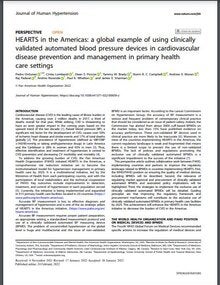HEARTS in the Americas: a global example of using clinically validated automated blood pressure devices in cardiovascular disease prevention and management in primary health care settings

|
IntroductionCardiovascular disease (CVD) is the leading cause of illness burden in the Americas, causing over 2 million deaths in 2017, a third of deaths overall for that year. While striking, CVD is threatening to have an even greater impact in the coming years based on the upward trend of the last decade [1]. Raised blood pressure (BP), a significant risk factor for the development of CVD, causes over 50% of ischemic heart disease and stroke events and 17% of total deaths globally [2]. The prevalence of hypertension (defined as SBP/DBP ≥140/90 mmHg or taking antihypertensive drugs) in Latin America and the Caribbean is 28% in women and 43% in men [3]. Thus, effective identification and treatment of hypertension is central to CVD prevention and decreasing CV morbidity and mortality [4]. To address the growing burden of CVD, the Pan American Health Organization (PAHO) initiated HEARTS in the Americas, a comprehensive risk reduction initiative set to become the institutionalized model for hypertension management in primary health care by 2025. It is a multinational initiative, led by the Ministries of Health from each participating country, and with the participation of local stakeholders and the technical cooperation of PAHO. Key outcomes include improvements in detection, treatment, and control of hypertension in each population served [5]. Currently, the initiative is being implemented and expanded in 915 primary health care facilities located in 20 countries (https://www.paho.org/en/hearts-americas). Accurate BP measurement is key to effective diagnosis and management of hypertension and is one of the six strategic pillars of HEARTS in the Americas initiative. (https://www.paho.org/en/hearts-americas). Accurate BP measurement requires proper patient preparation, an appropriate setting, a standardized measurement protocol and use of a clinically validated automated BP measuring device (BPMD). The problem of uncontrolled hypertension at the global level is huge and multifactorial and the issue of non-validated BPMD is an important factor. According to the Lancet Commission on Hypertension Group, the accuracy of BP measurement is a serious and frequent problem of contemporary clinical practice that should be considered as an issue of patient safety. Indeed, the Commission has alerted from about 3000 cuff-based BPMDs on the market today, less than 15% have published evidence on accuracy performance. These non-validated BP devices used in clinical practice are more likely to be inaccurate [6]. Moreover, in most of the countries implementing HEARTS in the Americas, the current regulatory landscape is weak and fragmented that means there is a limited scope to prevent the use of non-validated BPMDs. The lack of policies and regulations promoting the exclusive use of clinically validated automated BPMDs is a significant impediment to the success of the initiative [7]. This perspective article outlines collaborative work between PAHO, implementing countries and partners to improve the regulatory landscape related to BPMDs in countries implementing HEARTS. First, the WHO/PAHO position on ensuring the quality of medical devices, including BPMDs will be described. Second, the relevance of regulating market approval and procurement of clinically validated automated BPMDs and associated policy implications will be highlighted. Third, the strategies to implement the exclusive use of clinically validated automated BPMDs will be detailed. Guiding principles are that improving the regulatory framework and procurement mechanisms will contribute to the exclusive use of clinically validated automated BPMDs in primary health care facilities by 2025. This achievement will enhance the HEARTS in the Americas initiative to decrease the burden of CVD in the Americas. |
